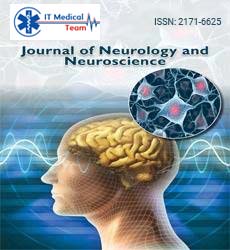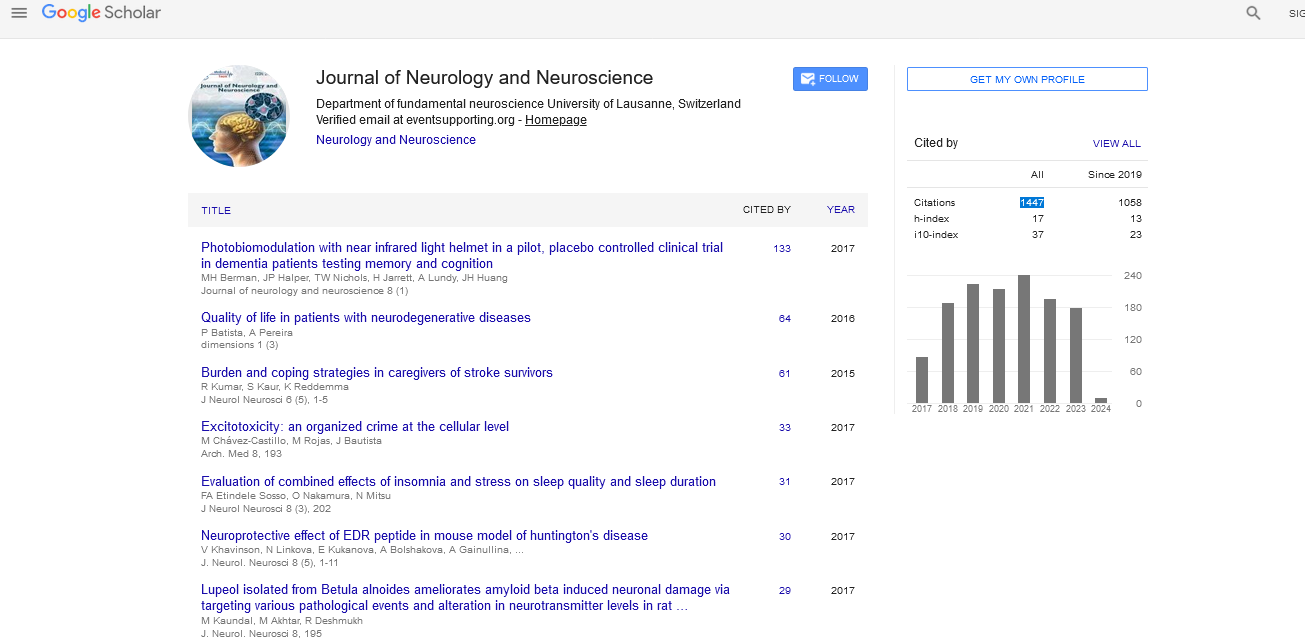Commentry - (2023) Volume 0, Issue 0
Causes of Obstructive Sleep Apnea and Associated Comorbidities Involved in Cognitive Impairment of Patients
Lawrence McCloskey*
Department of Behavioral Health, Wellspan Health System, York, Pennsylvania, USA
*Correspondence:
Lawrence McCloskey,
Department of Behavioral Health, Wellspan Health System, York, Pennsylvania,
USA,
Email:
Received: 29-May-2023, Manuscript No. IPJNN-23-13786;
Editor assigned: 31-May-2023, Pre QC No. IPJNN-23-13786 (PQ);
Reviewed: 14-Jun-2023, QC No. IPJNN-23-13786;
Revised: 21-Jun-2023, Manuscript No. IPJNN-23-13786 (R);
Published:
29-Jun-2023, DOI: 10.4172/2171-6625.23.S6.004
Description
As anyone with an interest in this subject knows, the
obstructive Sleep Apnea Syndrome (OSA) is a very common
condition in middle-aged and older adults which is commonly
associated with serious outcomes like reduced quality of life and
increased all-cause mortality. Despite some dissent, there has
emerged a rough consensus after decades of research that OSA
is also associated with mild cognitive impairments across a range
of domains. Although different reviewers have stressed different
ones, my own conclusion after perusal of this vast literature is
that Attention/Working Memory (A/WM), Executive Function
(EF), Episodic Memory (EM) and Speed of Information
Processing (SIP) may be most vulnerable, as they are in
depression and many other illnesses that are often comorbid
with OSA, including obesity, coronary atherosclerosis,
Hypertension (HTN) and Diabetes Mellitus (DM), in accord with
what Gaquoine in called “Frontal-Subcortical Ischemia” [1-3].
Therefore, some authorities have suspected that such
comorbidities may account for these impairments instead of
OSA itself. Moreover, the inconsistent correlations, summing to
nil in several meta-analyses, between the severity of OSA and
impairment in cognition further undercuts causality [1].
Commented here on the very scant literature which addresses
this important question directly.
Borges, et al. asserted truly in that EF is “a multifaceted
construct” whose impairment might not “be shown when
following the widely held practice” which holds widely across
other cognitive domains in this literature, of measuring it by only
one or a couple of tests [4]. Matched by age, gender, education,
intelligence and body-mass index, 22 treatment-naïve OSA
patients and 22 controls, all without obesity, psychopathology,
HTN or DM, did not differ on tests of attention, working
memory, planning, updating, set-shifting, and dual-tasking,
inhibition, flexibility, and verbal fluency. Acknowledging their
“limited sample size,” the authors concluded that “no clinically
significant executive effects are found in moderate and severe
(OSA) patients who are otherwise healthy”.
Seemingly unaware that they were partially replicating the
study above, Gnoni, et al. in early “undertook a proof of the
concept to define the cognitive pattern in a (rare) group of male,
middle-aged patients with untreated OSA who present without
comorbidities” of any kind [5]. Compared to 7 “healthy peopleeducation-
matched” controls, 11 patients with severe OSA
performed often substantially worse on tests of “executive
functioning, visuospatial short-term memory vigilance and
psychomotor control” which were “largely in keeping with
previous studies of OSA patients with associated multiple
comorbidities”. They also reported,” for the first time,
diminished social cognition”. Revealing a threshold effect,
patients with mild OSA “performed better than those with
severe OSA on most of those same tasks and rarely worse than
controls”.
Unaware in turn of the contemporaneous study above, I
sought also in early 2023 to approach causality from a different
direction by controlling comorbidities through multiple
regressions [1]. After partialing the presence or absence of HTN
and DM among 39 patients with mild to severe OSA, the Apnea-
Hypopnea Index (AHI; the most common measure of severity)
but not the Nadir Of Oxygen Saturation (NOS; the most common
measure of deoxygenation) predicted demographically
corrected, composite scores of several tests apiece which
tapped A/WM, EF and EM, accounting for 10-13 percent of the
variance. I interpreted this dose-response relationship as
evidence that OSA may cause mild deficits in these three
cognitive domains beyond those attributable to at least two of
its most frequent comorbidities.
These three germane studies (all that I could find) suffer by
tiny samples (as must be expected in proofs of concept), so all
stand in dire need of replication. Two of them sought the
advantage of a theoretical test of OSA’s unique cognitive effects
by recruiting more or less “pure” patients at the cost of
generalizability beyond the sliver of OSA patients without
contributory comorbidities [4,5]. This strategy prevented the
discovery of effects which might arise only in synergy with
comorbidities, however, and they contradicted each other
sharply besides. The third sought generalizability by accepting
“all comers” at the risk of the pitfalls of statistical control (like
overfitting), while covarying only two of OAS’s most frequent
comorbidities.
The next step to follow the latter (my own) strategy would be:
• To recruit a large, diverse sample to yield power enough to
control via multiple regression for more comorbidities
(preferably coded as continuous variables, like blood-pressure
readings, rather than simply present or absent);
• To control for demographic confounds while conserving
precious degrees of freedom by administering cognitive tests
with demographically-corrected norms; and
• To form composite measures of several tests in each cognitive
domain to cancel error and to map “multifaceted constructs”
like EF. More investigators also might consider
polysomnographic variables other than the traditional AHI and
NOS, including markers of sleep fragmentation (like the
arousal index) and sleep microstructure (like sleep spindles).
Yet their relation to mentation has been inconsistent, too
[6,7].
Conclusion
The particular cognitive impairments in OSA do seem to
support the oft-repeated hypothesis of frontal-subcortical
ischemia, inasmuch as they do occur as well in patients with
documented dysfunction in those areas. Their pathophysiology
in OSA remains highly speculative, however, and their geography
unconfirmed. In a meta-review of morphometric and functionalconnectivity
studies, for example, Yeung concluded that “no
brain region…was consistently reported across the metaanalyses
as significantly atrophied”. I wonder therefore whether
the cognitive tests which are taken to be the most “frontal” or
executive are merely the most sensitive to diffuse or variegated
cerebral dysfunction because they tap into broad networks.
Acknowledgement
None
Conflict of Interest
None
References
- McCloskey LC (2023) Mentation tracks severity but not oxygenation in obstructive sleep apnea. Percept Mot Skills 130:1-13.
[Crossref] [Google scholar] [PubMed]
- Lee RSC, Hermans DR, Porter MA (2012) A meta-analysis of cognitive deficits in first-episode major depressive disorder. J Affect Disord 140:113-124.
[Crossref] [Google scholar] [PubMed]
- Gasquoine PG (2011) Cognitive impairment in common, noncentral nervous system medical conditions of adults and the elderly. J Clin Exp Neuropsychol 33:486-496.
[Crossref] [Google scholar] [PubMed]
- Borges JG, Ginani GE, Hachul H (2013) Executive functioning in obstructive sleep apnea syndrome patients without comorbidities: Focus on the fractionation of executive functions. J Clin Exp Neuropsychol 35:1094-1107.
[Crossref] [Google scholar] [PubMed]
- Gnoni V, Mesquita RJ, O’Regan DO (2023) Distinct cognitive changes in male patients with obstructive sleep apnea without comorbidities. Front Sleep 1-11.
[Crossref] [Google scholar]
- Gu Y, Gagnon JF, Kaminska M (2023) Sleep eletroencephalography biomarkers in obstructive sleep apnea. J Sleep 1-50.
[Crossref] [PubMed]
- Yeung AWK (2019) Morphometric and functional connectivity changes in the brain of patients with obstructive sleep apnea. A meta-analysis. J Sleep Res 28: e12857.
[Crossref] [Google scholar] [PubMed]
Citation: McCloskey L (2023) Causes of Obstructive Sleep Apnea and Associated Comorbidities Involved in Cognitive Impairment of Patients. J Neurol Neurosci Vol.14 No.S6:004





